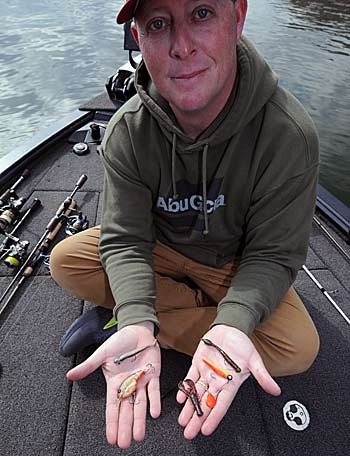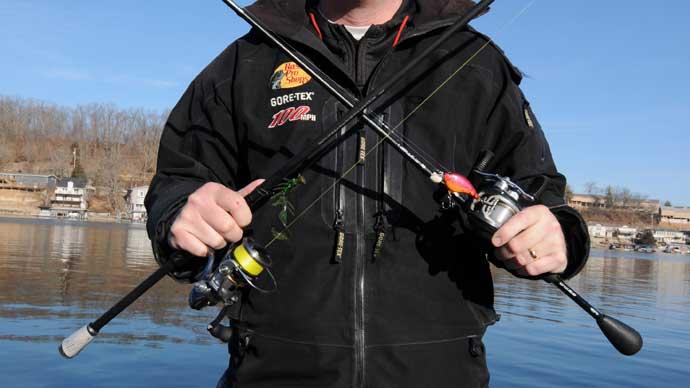
Even though bass get easier to catch in the spring, Missouri guide Jack Uxa’s job can still be a challenge.
Shallow springtime bass can be caught on various baits, so Uxa's challenge is determining which lures match the skill sets of his clients. "I take out guys who are preparing for tournaments regularly, and I take out people who have not fished in several years on a regular basis,” Uxa says. “So that is one of the hardest parts about my job is just me adapting to their skillset. I have to be able to read my people and help them get to the next little step that will help them become better fishermen.”
The Lake of the Ozarks guide has some factors to consider when selecting lures for beginners or novices. "Some people are natural born winders, and some people are okay with feeling the bottom with their lures, and I have to take that into account because some people struggle with a bottom bait, especially on this lake, which is a rocky lake with relatively clear water and deep drop-offs,” Uxa says. “Some people are used to that stuff, but if some people think 20 feet of water is deep, they struggle with that, so I am better off not giving them a lure that is too much for them (to feel in deeper water).”
Uxa tries to set up his novice clients with simple lures that are easy to cast and retrieve and have high hookup rates. The following four simple lures are Uxa's picks for novices when springtime bass are in the shallows.
Ned Rig
The do-nothing Ned rig is the perfect simple finesse tactic for novices.
"You can take this rig and go behind several other fishermen on a lake that gets a lot of fishing pressure, throw something really small with it, and still have some pretty good success," Uxa says. "It doesn’t have a lot of flash to it. Bass get tired of seeing all these cool baits like spinnerbaits, and sometimes throwing something really finesse is the name of the game."
Uxa sets up his rig with a 1/8-ounce jighead and either a Crock-O-Gator Shortie worm or a Berkley MaxScent Lil’ Super Trooper plastic crawfish. The jighead has a weedguard, which helps prevent his clients from hanging up the rig in rocks or wood cover.
Simply shaking the Ned rig and bouncing it along the bottom usually triggers strikes. "I throw my bait up towards the bank, and I am just bouncing my rod tip a little," Uxa says. The guide has his clients fish the Ned rig from 1 to 10 feet deep. The Ned rig has a good hookup rate, but Uxa still encourages his clients to set the hook hard to increase their chances of landing bass.
Uxa’s Ned rig tackle consists of a 6-foot, 6-inch medium-action spinning rod and spinning reel spooled with a main line of 10-pound braid and a 10-pound fluorocarbon leader.
Soft Plastic Swimbait
“This is a great bait after a front has passed through an area, and the bass are not as aggressive as they were before that front," Uxa says. "The bass are still moving and active enough to chase down a bait."
The Missouri angler opts for a 2.8-inch Berkley PowerBait Power Swimmer paddletail swimbait he rigs on a 1/8-ounce Dirty Jigs Guppy Swimbait jighead. The small swimbait is easy for novices to use because they can simply cast it out and slowly and steadily wind it in without imparting any extra action. “The deal with this bait is it already has built-in action with its tail,” Uxa says. “If you pop it too much, you will mess up the bait's action."

The swimbait produces best for Uxa’s clients in the clear water of shallow bays. The lure imitates shore minnows in the shallows, where Uxa fancasts with a 6' 9" medium-light spinning rod and 10-pound Berkley FireLine braid with a 10-pound fluorocarbon leader.
Flat-Sided Crankbait
"This is a bait you can use in slightly stained water or in clear water with a little bit more cloud cover,” Uxa says.
The guide’s favorite flat-sided crankbait for shallow springtime bass is a Berkley Frittside 5 in a HD brown or red craw hue. “You can pretty much throw these crankbaits right out of the box,” he says. “They dive about 5 feet deep and are pretty good as a versatile bait. You can also throw these crankbaits on smaller lakes, ponds, or rivers.”
The crankbait will draw strikes by simply winding in the lure steadily, but Uxa recommends more of a stop-and-go retrieve. “I do use a lot of pausing with this bait, and I kind of twitch it a little bit,” he says.
The lure is equipped with two Fusion 19 treble hooks, which offer a good hookup ratio for Uxa’s clients. The guide has his clients throw the crankbait on an Abu Garcia Veritas 7-foot medium action spinning rod and 15-pound test Berkley Jordan Lee x9 braid with an 8-pound leader of monofilament or fluorocarbon line.
Beetle Spin
“It’s one of those baits we laugh a little bit about because it has been around forever, and a lot of children throw it,” Uxa says. "It's so old school that many people have forgotten about it."
The Missouri guide likens the almost forgotten Johnson Original Beetle Spin to a finesse spinnerbait, which he will use in off-colored water. "It still has that little bit of vibration and it still has the right movement to draw bass to the bait,” Uxa says. “It will still catch bass, especially this time of year when we get a lot of big storms that affect the water clarity and dirties up the water."
The small profile lure is easy to cast and quickly covers water with a slow, moderate retrieve. "It's a bait that you just throw out there and wind it back," Uxa says. He usually runs the 1/4-ounce Beetle Spin from the bank to 4 or 5 feet deep.
Bass usually hook themselves when they attack the Beetle Spin. "You just yank back, and usually you get the fish," Uxa says of the hookset.
The Beetle Spin works best for Uxa's clients on a 6' 6" medium-action spinning rod and 15-pound braid main line with a 10-pound monofilament or fluorocarbon leader.
If you are looking for a simple way to catch bass this spring, try these four lures veteran guide Jack Uxa selects for his inexperienced clients.
BassResource may receive a portion of revenues if you make a purchase using a link above.




